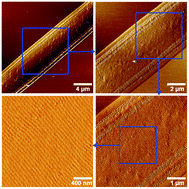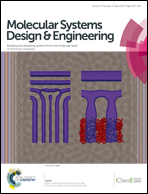Preferred domain orientation in block copolymer fibers after solvent annealing†
Abstract
Block copolymer fibers represent an emerging class of nanomaterials with attractive properties and functionalities. Previous work has used coaxial electrospinning to prepare block copolymer fibers in thermally stable sheaths, which allow for thermal annealing of the block copolymers to form ordered nanostructures. However, the resulting nanostructures are mostly concentric due to isotropic boundary conditions at the sheaths. Herein, we describe a strategy of utilizing solvent annealing to achieve ordered block copolymer nanostructures in fibers. Cylinder- and lamella-forming poly(methyl methacrylate-block-styrene) (PMMA-b-PS) block copolymers are synthesized via reversible addition–fragmentation chain transfer polymerization and electrospun into fibers. After solvent annealing, the block copolymers can form long-range ordered nanostructures and exhibit a preferred domain orientation that is perpendicular to the fiber axis. Complementary to thermal annealing of coaxially electrospun block copolymer fibers, the method of solvent annealing provides an alternative approach for controlling the block copolymer domain orientation in fibers.

- This article is part of the themed collection: Advances in Directed Self-Assembly


 Please wait while we load your content...
Please wait while we load your content...